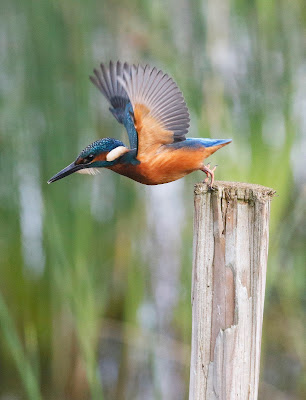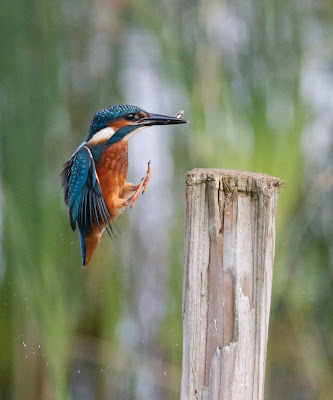A night of heavy rain ushered in a morning of wet greyness but slowly the clouds became fragmented by the warm and unseasonably strong southerly wind that had been blowing all night and the subsequent sunny spells lightened my spirits. It looked very much that the persistent wind had finally blown the rain clouds away.
I determined to go to Farmoor Reservoir and resume my admiration of the Kingfishers currently coming to the secluded pool at Shrike Meadow. These birds have now become well known, almost celebrities and have attracted attention from many local people as well as some from more distant parts. Yesterday I was told the normally deserted hide was crowded and so it was that tentatively I opened the hide door at just before ten on this blustery morning.
I was in for a pleasant surprise as I found only Steve, a fellow Oxonbirder, ensconced on the unforgiving hard wooden benches. I sat with him and was told a Kingfisher had just departed having been present for half an hour. I was pleased for Steve as he had spent six unrewarded hours here on Saturday.
Not a great deal of time passed before the Kingfisher returned, flying in over the far reed bed and scudding low over the water to pitch on to its customary post and I joined Steve in clicking away with my camera before it departed, only to return after just a few minutes absence. The morning sunlight was gentle as it shone, in one of its intermittent appearances, on the Kingfisher, perched and forever vigilant on the post, its plumage illuminated and sparkling in the sunlight, as if a jewel had crowned the unpreposessing but now celebrated post.
I have covered just about everything and anything that one usually does in my previous posts about the Kingfishers of Shrike Meadow so on this occasion I made a conscious decision to strive for images of the Kingfisher that were not the usual, tempting though those may be, but to try for something that illustrated less photographed behavioural aspects of the bird rather than it just sitting on a post and looking pretty, which it unknowingly does for much of the time.
To achieve this I obviously needed the Kingfisher to be present but during its absence I sat and pondered on the words of naturalists and poets who had been stimulated by Kingfishers for whatever reason. It is inevitable that a bird such as the Kingfisher, made attractive by its spectacular plumage and idiosyncratic lifestyle should be a constant source of fascination to writers, poets and naturalists.
The English poet and Jesuit priest Gerald Manley Hopkins who lived in Victorian times and spent much of his life in Oxford wrote a poem about the Kingfisher called 'As Kingfishers catch Fire.' The first line of the poem reads 'As Kingfishers catch Fire, dragonflies draw flame' and sitting in the hide and looking out on the pool, an oasis of stillness within the surrounding wind buffeted reed beds the words of the poet came true and to life, from across the years, as the Kingfisher arrived in a blaze of orange and blue, literally the colours of flame while an Emperor Dragonfly curved and dipped its long body into the shallow waters to deposit its eggs. The poem, although superficially mentioning a Kingfisher was written by the devout poet as a vehicle to praise God for producing such marvels of creation as the Kingfisher.
A more prosaic and certainly less romantic view of the Kingfisher was provided by Charles Coward, a much less celebrated, almost forgotten naturalist and also from the Victorian era who described it thus. 'Here is a bird dwelling in his bone crypt, living a life of lonely divagations along wintry rivers alone with its terrible beauty.'
Our perception of the Kingfisher as a creature of great beauty due to its wonderful blue colouration is also based on a misapprehension, a trick of the light one might say. The upperpart feathers, so luminous in their intensity, especially the azure blue on the back, are not that colour at all but actually a dull brown colour. The feathers have no blue pigment or iridescence, the blue is caused by the structure of the feathers, where light striking specially modified layers of feather cells creates a blue light.
Kingfishers for all their outward beauty lead a solitary, unappealing and harsh existence, requiring at least a kilometre of river to themselves as a territory and when breeding, the nest hole they excavate becomes increasingly insanitary and foul smelling, even rancid with rotting fish and bones as the growing young are fed by the adults.
A more prosaic and certainly less romantic view of the Kingfisher was provided by Charles Coward, a much less celebrated, almost forgotten naturalist and also from the Victorian era who described it thus. 'Here is a bird dwelling in his bone crypt, living a life of lonely divagations along wintry rivers alone with its terrible beauty.'
Our perception of the Kingfisher as a creature of great beauty due to its wonderful blue colouration is also based on a misapprehension, a trick of the light one might say. The upperpart feathers, so luminous in their intensity, especially the azure blue on the back, are not that colour at all but actually a dull brown colour. The feathers have no blue pigment or iridescence, the blue is caused by the structure of the feathers, where light striking specially modified layers of feather cells creates a blue light.
Kingfishers for all their outward beauty lead a solitary, unappealing and harsh existence, requiring at least a kilometre of river to themselves as a territory and when breeding, the nest hole they excavate becomes increasingly insanitary and foul smelling, even rancid with rotting fish and bones as the growing young are fed by the adults.
Such musings were soon banished as the Kingfisher returned for a third time to resume its vigil on the post and where it subsequently remained for the best part of forty five minutes. Its arrival prompted me to consider the similarities between this natural avian missile and those less attractive man made instruments of destruction owned by armed forces around the world. The bird is pointed at one end and blunt ended at the other as is a missile, the pointed end in both cases is the business end. For the Kingfisher it is the one to carry the punch as it dives head first from its perch, hitting the water explosively, to spear its prey underwater with its formidable bill. Both travel at high speed, in the case of the Kingfisher flying low over the water then rising up to make a faultless landing on its perch without seeming to decrease speed.
On my previous visits I saw the Kingfisher make mostly unsuccessful dives from its post after prey, its lack of success probably due to it being a young and inexperienced bird. This point in their life is crucial for a young Kingfisher if it is to survive. Up to fifty percent of young Kingfishers do not survive to adulthood, with many failing to live longer than two weeks after leaving the nest. This is why Kingfishers can have up to three broods of five or six young in a year. Despite the young looking as equally beautiful as their parents when they leave the nest, nature has no sentiment and at least half will die within days.
I do not know how many Kingfishers currently visit this pool but presume that those that do are the successful ones and have managed to survive their first critical days out of the nest.The next challenge will be to survive the winter, for if it is a hard one many Kingfishers will succumb as the still or slow moving waters they need to fish in become frozen over. Thankfully the Kingfishers here have the River Thames which continues to flow whatever the weather.
Normally it is only one juvenile Kingfisher that is present at any one time at Shrike Meadow. The attraction of the pool for a young inexperienced Kingfisher is obvious in that it is secluded, with relatively easy fishing as the water is shallow and clear, and has a plentiful supply of prey.
On my previous visits I saw the Kingfisher make mostly unsuccessful dives from its post after prey, its lack of success probably due to it being a young and inexperienced bird. This point in their life is crucial for a young Kingfisher if it is to survive. Up to fifty percent of young Kingfishers do not survive to adulthood, with many failing to live longer than two weeks after leaving the nest. This is why Kingfishers can have up to three broods of five or six young in a year. Despite the young looking as equally beautiful as their parents when they leave the nest, nature has no sentiment and at least half will die within days.
I do not know how many Kingfishers currently visit this pool but presume that those that do are the successful ones and have managed to survive their first critical days out of the nest.The next challenge will be to survive the winter, for if it is a hard one many Kingfishers will succumb as the still or slow moving waters they need to fish in become frozen over. Thankfully the Kingfishers here have the River Thames which continues to flow whatever the weather.
Normally it is only one juvenile Kingfisher that is present at any one time at Shrike Meadow. The attraction of the pool for a young inexperienced Kingfisher is obvious in that it is secluded, with relatively easy fishing as the water is shallow and clear, and has a plentiful supply of prey.
Today the Kingfisher visiting the pool was much more successful than on previous occasions, catching both water beetles and small fish, which it took back to the post and either swallowed immediately or beat against the post until satisfied the prey was dead.
On one notable occasion it coughed up a pellet of indigestible chitinous material which fell to the water.
On one notable occasion it coughed up a pellet of indigestible chitinous material which fell to the water.
 |
| Discarding a pellet |
Briefly it tensed. looking skyward at, probably, a Red Kite passing overhead. Its plumage flattened to its body which now took on a less accustomed thinner appearance, reducing its profile, head and body in alignment, bill pointing skyward as it followed the cause of its concern.
Once the perceived danger had passed it resumed its relaxed position on the post but eventually hunger stirred it from its reverie and after a quick scratch and extending its wings, first the right and then the left, before half raising both in one last final stretch, it was ready for action once more.
It was now totally alert and proceeded to launch itself from the post at intervals to catch both beetles and small fish which it swallowed, once it had resumed its position on the post.
It left its perch for the final time and like an azure bolt fired from a crossbow, arrowed across the pool in front of the hide and was gone through a gap in the swaying trees, towards the nearby river.
I left it at that. There is really nothing more to be said.









































Great stuff - love the dive/return shots!!! I finally got over there yesterday morning & got pretty lucky, but didn't get as far as trying for dive shots.... x
ReplyDelete